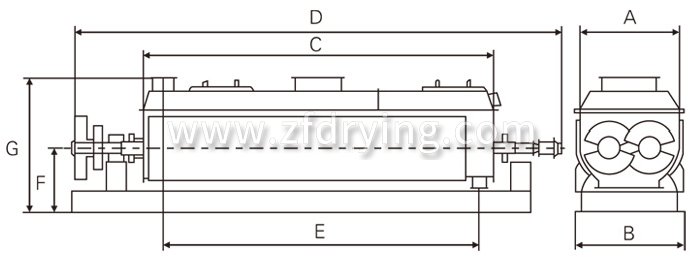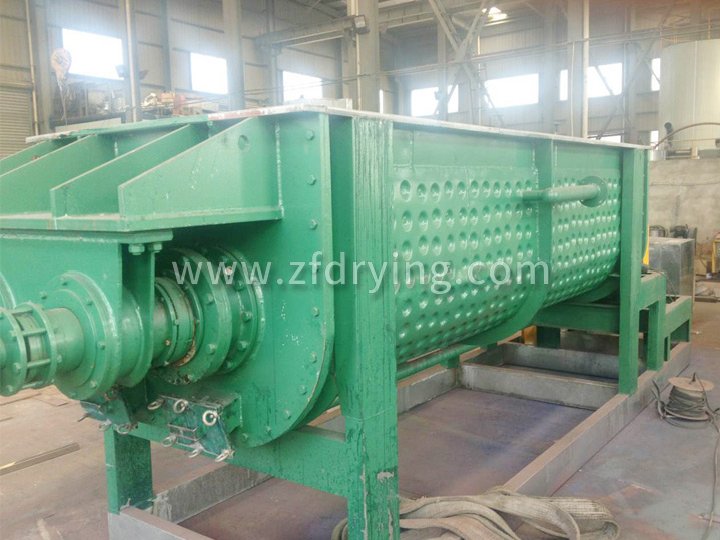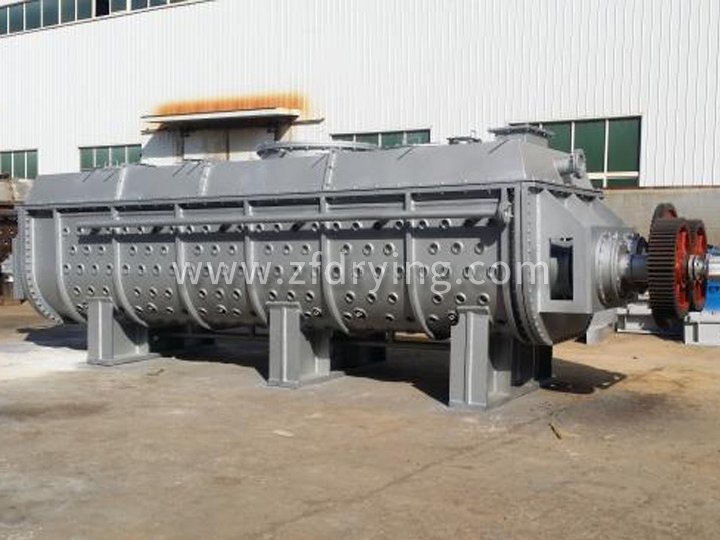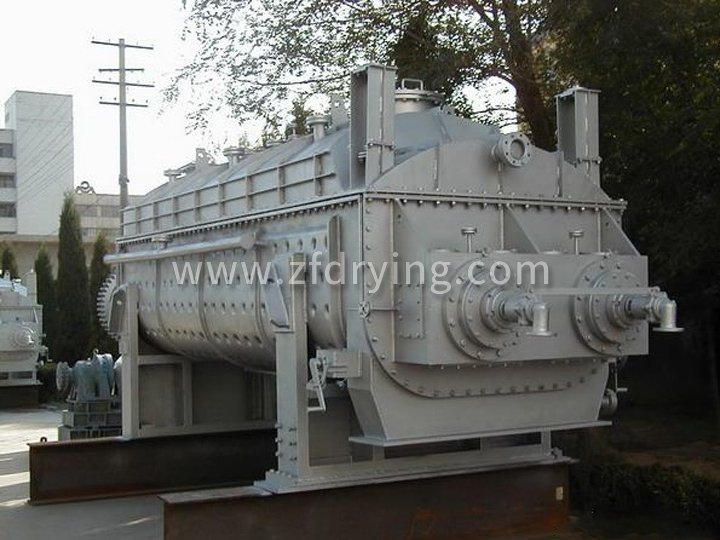Product Introduction
This product can indirectly heat or cool paste, granular, powder, and slurry materials, and can complete unit operations such as drying, cooling, heating, sterilization, reaction, and low-temperature combustion. The special wedge-shaped stirring heat transfer blade in the equipment has high heat transfer efficiency and self-cleaning function of the heat transfer surface.
Operational principle
Wedge shaped hollow blades are densely arranged on the hollow shaft, and the thermal medium flows through the blades through the hollow shaft. The heat transfer area per unit effective volume is large, and the temperature of the thermal medium ranges from -40 ℃ to 320 ℃. It can be water vapor or liquid, such as hot water, heat transfer oil, etc. Indirect conduction heating does not carry air away heat, and the heat is used to heat the material. The heat loss is only the heat dissipation to the environment through the insulation layer of the body. The heat transfer surface of the wedge-shaped blade has self-cleaning function. The relative motion between material particles and the wedge surface produces a washing effect, which can wash away the attached materials on the wedge surface and maintain a clean heat transfer surface during operation. The shell of the paddle dryer is an Ω type, with two to four hollow mixing shafts generally arranged inside the shell. The shell has a sealed end cover and an upper cover to prevent the leakage of material dust and fully play its role.
The heat transfer medium flows through the shell jacket and the hollow stirring shaft through a rotating joint. The hollow stirring shaft has different internal structures based on the type of heat medium to ensure better heat transfer effect.
Performance characteristics
Low energy consumption of the paddle dryer: due to indirect heating, there is not a large amount of air to carry away heat. The outer wall of the dryer is also equipped with an insulation layer, and for slurry materials, only 1.2kg of water vapor is needed to evaporate 1kg of water.
The cost of the blade dryer system is low: it has a huge heat transfer surface per unit of effective volume, which shortens the processing time and reduces the equipment size. This greatly reduces the building area and space.
◎ Wide range of material processing: using different thermal media, it can handle both heat-sensitive materials and materials that require high-temperature treatment. Commonly used media include: steam, heat transfer oil, hot water, cooling water, etc.
It can be operated continuously or intermittently and can be applied in many fields.
Low environmental pollution: Do not use carrying air, and there is little dust and material entrainment. The solvent evaporation of the material is very small, making it easy to handle. For contaminated materials or working conditions that require solvent recovery, the following methods can be used
Closed loop.
◎ Low operating cost: structure. Low wear and tear, low maintenance costs.
◎ Stable operation: Due to the special compression expansion stirring effect of the wedge-shaped blade, the material particles fully come into contact with the heat transfer surface. Within the axial range, the temperature, humidity, and mixing gradient of the material are very small, thus ensuring the stability of the process.
Adapt to materials
Paddle dryers have been successfully used in fields such as food, chemical, petrochemical, dye, and industrial sludge. The characteristics of heat transfer, cooling, and stirring of the equipment enable it to complete the following unit operations: combustion (low temperature), cooling, drying (solvent recovery), heating (melting), reaction, and sterilization. The stirring blade is also a heat transfer surface, which increases the heat transfer area per unit effective volume and shortens the processing time. The heat transfer surface of the wedge-shaped blade also has self-cleaning function. The compression expansion mixing function ensures uniform mixing of materials. The material moves in a "piston flow" along the axial direction, and within the axial range, the temperature and humidity of the material

Technical specifications
|
Project/Model
|
JYG3
|
JYG9
|
JYG13
|
JYG18
|
JYG29
|
JYG41
|
JYG52
|
JYG68
|
JYG81
|
JYG95
|
JYG110
|
|
heat transfer area(m2)
|
3
|
9
|
13
|
18
|
29
|
41
|
52
|
68
|
81
|
95
|
110
|
|
Effective volume(m3)
|
0.06
|
0.32
|
0.59
|
1.09
|
1.85
|
2.8
|
3.96
|
5.21
|
6.43
|
8.07
|
9.46
|
|
speed range(rmp)
|
15-30
|
10-25
|
10-25
|
10-20
|
10-20
|
10-20
|
10-20
|
10-20
|
5-15
|
5-15
|
5-10
|
|
power(kw)
|
2.2
|
4
|
5.5
|
7.5
|
11
|
15
|
30
|
45
|
55
|
75
|
95
|
|
Body width A(mm)
|
306
|
584
|
762
|
940
|
1118
|
1296
|
1476
|
1652
|
1828
|
2032
|
2210
|
|
Width B(mm)
|
736
|
841
|
1066
|
1320
|
1474
|
1676
|
1854
|
2134
|
1186
|
2438
|
2668
|
|
Body width C(mm)
|
1956
|
2820
|
3048
|
3328
|
4114
|
4724
|
5258
|
5842
|
6020
|
6124
|
6122
|
|
Total length D(mm)
|
2972
|
4876
|
5486
|
5918
|
6808
|
7570
|
8306
|
9296
|
9678
|
9704
|
9880
|
|
Incoming and outgoing distance E(mm)
|
1752
|
2540
|
2768
|
3048
|
3810
|
4420
|
4954
|
5384
|
5562
|
5664
|
5664
|
|
center height F(mm)
|
380
|
380
|
534
|
610
|
762
|
915
|
1066
|
1220
|
1220
|
1220
|
1220
|
|
Height H(mm)
|
762
|
838
|
1092
|
1270
|
1524
|
1778
|
2032
|
2362
|
2464
|
2566
|
2668
|
|
steam inlet N(cun)
|
3/4
|
3/4
|
1
|
1
|
1
|
1
|
11/2
|
11/2
|
11/2
|
11/2
|
2
|
|
delivery port O(cun)
|
3/4
|
3/4
|
1
|
1
|
1
|
1
|
11/2
|
11/2
|
11/2
|
11/2
|
2
|




